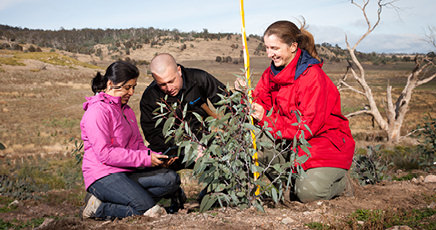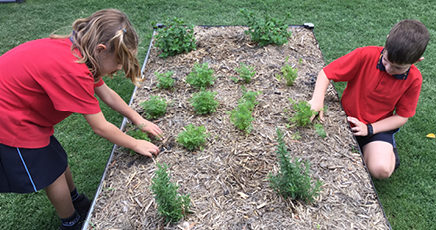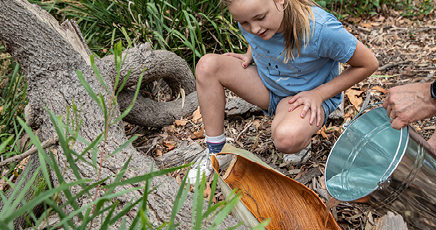LEARNING ACTIVITY
STORY
After six months, some of the students started to spot creatures in the wildlife habitat they had created. Everyone was so excited. Suyin’s teacher decided to organise a presentation event at the school assembly. Each class would take turns to creatively present their project showcasing their learnings, they could make posters or present photos. Each class was also tasked to name the wildlife habitat they had created to help raise awareness within the school and local community.
Suyin could not believe how her small idea had grown. All she wanted to do was protect the native animals in her backyard, and help the children that live in urban environments realise that they too can have native wildlife in their backyard.

Monitoring and care helps provide an understanding of how your garden grows. What does it need to be healthy, to support growth, and be a native habitat?
This learning activity is the final part of a sequence of 5 individual learning activities focused on creating a wildlife habitat. The order of these learning activities are: research, vision, design, planting and monitoring and care.
We encourage our Junior Landcarers to learn more about caring for their wildlife habitat garden by exploring these other learning activities. These include the Understanding weeds sequence: lifecycle and investigation along with Growing healthy plants using natural pesticides.
For children to:
- monitor and care for the health of the wildlife garden
- monitor the species that are using the wildlife habitat
- look at ways they can help create wildlife habitats
- enjoy being active and productive outdoors and build their social and teamwork skills
- understand the steps involved in creating a wildlife habitat.
Monitoring and care of your wildlife habitat should be done all year round. Monitoring animals is best done during the warmer months, before the hottest part of the day, when there are more of them to see.
Introduction
What happens now that you have finished creating a wildlife habitat? The monitoring and care phase is important to ensure all your hard work isn’t washed away, and that your plants are healthy and growing well. It is also a great way to find out if your wildlife habitat is a success, and providing a home for local wildlife.
*Time allocation will be dependent on site selection and travel time. Additional time may be spent in consultation with your local Landcare group, council, or Indigenous plant nursery.
Checklist
Instructions
Step 1
Why should we monitor and care?
Now you have finished creating a wildlife habitat, what’s next?
Discuss as a class why monitoring and caring for your wildlife habitat is an important phase of your project. Including the following:
- why is water important for plant growth?
- are all insects in our garden pests?
- how can we tell if our garden is healthy?
Step 2
Making a rain gauge
Rain helps sustain life and provides water for plants to help them grow. You can determine if you need to add more water to your wildlife habitat by monitoring the rainfall. A simple way to do this is by making a rain gauge.
- Using scissors, carefully cut the top section off a 1.25L clear bottle.
- Fill the bottom of the bottle with small rocks for weight (2cm deep).
- From the top of the rock layer, mark out 1cm intervals on the side of the bottle with a ruler and permanent black marker.
- Fill the bottle with water up to the top of the rock layer.
- Make a funnel by inverting the top of the bottle you cut off in step 1
- Place the rain gauge in your fauna habitat where it will be exposed to rainfall, making sure to secure around it with rocks so it doesn’t fall over.
When it rains, observe and record the rainfall amounts. If there has been a lot of rain, there is no need to water the garden.
Step 3
Monitoring growth, looking for pests
Another important part of monitoring is recording the growth of your plants.
Use the growth chart in the activity sheet to monitor the garden. Record the height and width of your plants.
Measure from the top of the soil straight up to the highest tip of the plant to determine the height.
A sewing tape measure can be used to measure the circumference of the plants to see if they are getting wider/fuller.
Other than water, another factor affecting growth are pests. There are many beneficial insects living in your garden that help your plants stay healthy. There are also pests that cause damage.
Use the link to find the best natural pesticides for the pests that cause damage. Natural pesticides will help keep your plants healthy.
Step 4
Processing and applying learning
You have finally created a wildlife habitat, but how do you know if animals are using your garden?
When you are monitoring and caring for your garden take a few minutes to look around and make observations. Look on the ground, in the trees and shrubs and up in the air.
Can you see any scats (animal poo), tracks, or traces? Can you hear any new animal calls or noises?
Write these down with the other observations in your Planting Activity Sheets.
To finish this stage of the project, have a discussion in your class about the long term approach for your new habitat. How will you look after it, how will you monitor what visits and lives in the habitat, how can you encourage even more wildlife to your garden.
Keep the Junior Landcare group, garden club, school council and P&C involved in the long term care of your wildlife habitat garden.
Extension Activity
Celebrate the establishment of your garden and ask the local Traditional owners to come and provide a talk or Welcome to Country.
Get your Junior Landcare group to develop monitoring programs for the animals that now live in your native wildlife garden.
Curriculum and Framework Links
SCIENCE
Year 3: ACSHE050, ACSIS053, ACSIS054, ACSIS057, ACSIS215, ACSIS060
Year 4: ACSSU075, ACSSU073, ACSIS064, ACSIS216, ACSIS071
Year 5: ACSSU043, ACSHE083, ACSIS231, ACSIS086, ACSIS090
Year 6: ACSSU094, ACSSU096, ACSHE098, ACSHE100, ACSIS221, ACSIS110
Year 7: ACSSU112, ACSSU116, ACSHE223, ACSHE120, ACSHE121, ACSIS125, ACSIS133
Year 8: ACSHE135, ACSHE136, ACSIS139, ACSIS145, ACSIS148
GEOGRAPHY
Year 7: ACHGK037, ACHGK038, ACHGK039, ACHGK040, ACHGK042, ACHGS050
Year 8: ACHGK051, ACHGK052, ACHGK053
HUMANITIES, ARTS & SOCIAL SCIENCES
Year 3: ACHASSK072
Year 5: ACHASSK114, ACHASSK118
HEALTH AND PHYSICAL EDUCATION
Year 3 & 4: ACPPS035, ACPPS038
Year 5 & 6: ACPPS056
Year 7 & 8: ACPPS073
ETHICAL UNDERSTANDING
Exploring values, rights and responsibilities
PERSONAL AND SOCIAL CAPABILITY
Social awareness
CURRICULUM CONNECTIONS
Outdoor Learning
CROSS CURRICULUM PRIORITY
Sustainability
MY TIME, OUR PLACE: FRAMEWORK FOR SCHOOL AGE CARE
Outcome 2 and 4
Reference List
ONLINE RESOURCES
Find out more about Landcare on the Landcare Australia website.
Look at the Growing healthy plants using natural pesticides activity on the Learning Centre to get ideas about natural pesticides.
You can find some more natural pesticides on the Gardening Australia website.
WATCH
TedED Do we really need pesticides?
Find out about rain by watching How does rain form and what is the water cycle?
IMAGE ATTRIBUTION
Photo of native bee courtesy of Julie Armstrong
We value your feedback
When you have finished this learning activity, please tell us what you think with our survey.
Your feedback will help Landcare Australia improve the activities in the Junior Landcare Learning Centre.
Why not try one of our other Junior Landcare learning activities?
Creating a butterfly garden
Biodiversity
Love Letters to the Land
Biodiversity|First Nations Perspectives|Food Production|Waste Management
Creating a sensory garden
Biodiversity
Understanding weeds: life cycle
Biodiversity


